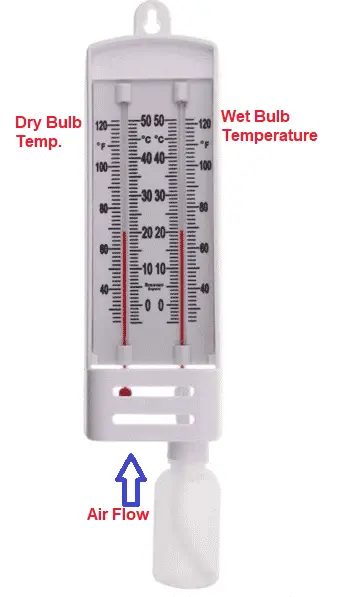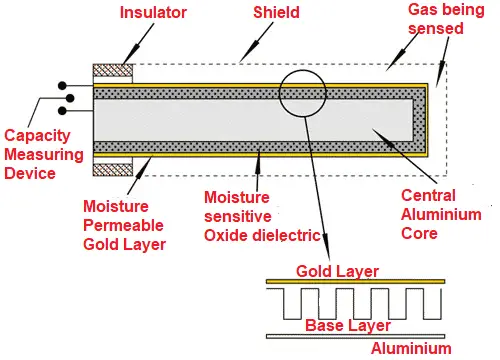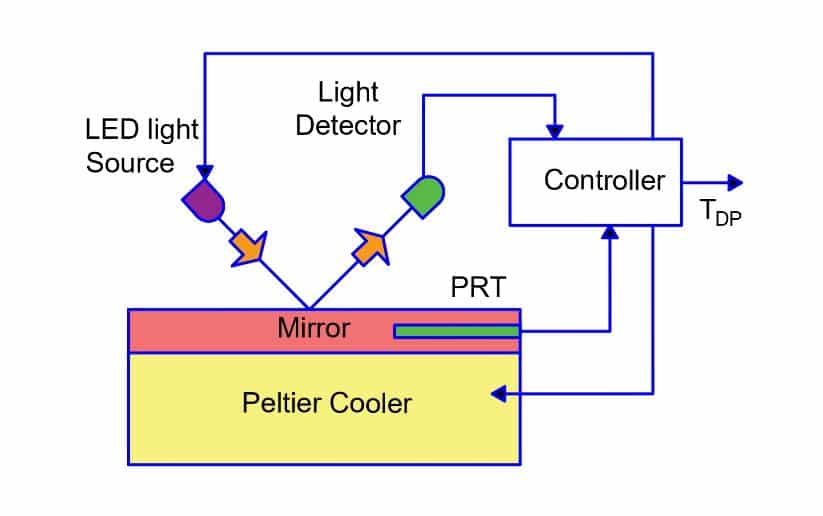In this article we will discuss the humidity measurement principle in detail. Humidity measurement is a very important factor to know the status of the environment. We daily use the term humidity to state the status of the surrounding environment.
What is humidity?
Humidity is the measure of the amount of water vapor present in the surrounding environment. Therefore, humidity plays a very important role in affecting the surrounding material and all its properties. Even, the air quality deteriorates with the change in humidity.
Water vapor is usually invisible and behaves like a gas unless it condenses on water or ice. Even in the absence of condensation, water vapor can react with the surface and penetrate the material. The capacity of the gas (or space) that holds the water vapor depends on its temperature. As a result, the higher temperature retains more water vapor.
Humidity measurement is very important in preventing or maintaining corrosion, condensation, mould, warping, or other spoilage of products. This is also important in maintaining the quality of foods, chemicals, pharmaceuticals, fuels, paper, wood, and many other products.
Building air conditioning systems often control humidity, and air conditioning takes a huge amount of energy to remove water vapor from the air. Humidity measurements help both achieve the correct environmental conditions and minimize the associated energy costs.
Some important terms related to Humidity
Relative Humidity
Relative humidity (RH) is the percentage of water that air can hold at a particular temperature and a particular pressure. Hence relative humidity is a temperature-dependent quantity. The relative humidity is denoted by %RH.
Dew Point
Dew point is the temperature at or below which the water vapor present in the atmosphere will start to condense. It is measured in terms of temperature. We usually say that the instrument air is having a dew point of -40 oC. This means that at or below -40 oC, water droplets are visible for the given instrument air.
Humidity Measurement Principle and Methods
Measurement of humidity is a very difficult task as compared to measuring other process parameters. Also, the instruments used for measuring the humidity are very expensive. Therefore, utmost care is a must to handle these instruments. Also, calibration of humidity measuring instruments is very difficult. Let us discuss methods for humidity measurement principle. There are three methods of humidity measurement.
- Psychrometric Method
- Dew Point method
- Condensation Method
Psychrometric Method of Humidity Measurement
The psychrometric method is suitable for measuring relative humidity. This method is one of the oldest methods for measuring relative humidity. The other name of the Psychrometric method is the dry bulb and wet bulb method. In the psychrometric method, we do not measure direct humidity. But here we measure the temperature to find out the relative humidity.
Temperature measuring sensors, such as thermometers, RTDs, and thermistors are the primary sensors for the Psychrometric method. The dry bulb measures the ambient temperature. While the wet bulb has an attachment of a wet cloth with distilled water on the tip of the temperature measuring device.
The temperature measured by both these bulbs will be different because in wet bulb humidity is also a factor. The wet-bulb temperature is generally less than the dry-bulb temperature. Based on both these temperatures we can tell the value of relative humidity from both the psychrometer chart.
In modern psychrometers, the inbuilt microprocessor is present which tells the exact value of the relative humidity. The accuracy of the psychrometer is near 2%. Generally, it can measure humidity in the range from 10% to 100% for temperatures from oC to 60 oC. The response time is a bit slow and the expense is also high for psychrometers.

Dew Point method
The dew point sensor consists of a high purity aluminum wire. The chemically oxidized surface of aluminum wire produces an insulating layer that is porous and of partially hydrated aluminum oxide. Then a porous but conductive gold film is deposited on top of the oxide layer. Thus. the gold film and the aluminum wire form two plates of the capacitor.
The oxide layer that forms the dielectric barrier of a capacitor is in the form of a mass of tubular pores that extend from the aluminum core to the exposed surface. The water absorbed in these pores is directly related to the water content of the gas surrounding the sensor, as the dynamic equilibrium is maintained between the water vapor outside the sensor and the water absorbed inside the sensor.
A change in the amount of moisture present in the sample air changes the capacitance value. This value is used by the microprocessor to calculate the dew point. In other words, this method measures the trace of the water vapor in the air sample.
The dewpoint range covered by the sensor is –110 oC to +20 oC dewpoint, which corresponds to 0.001 ppm to 0.2 percent by volume.

Condensation Method of Humidity Measurement
In this method, air controlled by a Peltier Cooler flows over a chilled mirror. The controller controls the cooling by controlling the current to the Peltier cooler. A thermistor mounted on the mirror measures the temperature. A regulated LED illuminates the mirror. This mirror reflects the light on the photodiode.
As water vapor condenses on the mirror, light received by the photodiode reduces due to the scattering of light. Now to compensate for this light, the current is increased and decreased to maintain the temperature of the mirror.

This is done such that the rate of condensation and evaporation of the water molecules and mass of the water on the mirror is constant. The temperature of the mirror is the dew point temperature. Using this method, we can measure humidity from 0 %RH to 100 %RH.